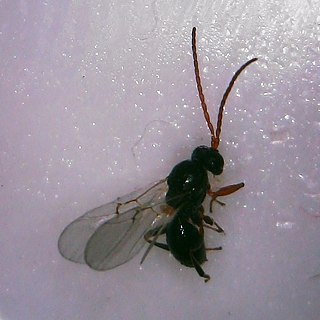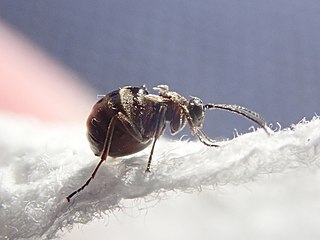
Fig wasps are wasps of the superfamily Chalcidoidea which spend their larval stage inside figs. Some are pollinators but others simply feed off the plant. The non-pollinators belong to several groups within the superfamily Chalcidoidea, while the pollinators are in the family Agaonidae. While pollinating fig wasps are gall-makers, the remaining types either make their own galls or usurp the galls of other fig wasps; reports of their being parasitoids are considered dubious.

Chalcid wasps are insects within the superfamily Chalcidoidea, part of the order Hymenoptera. The superfamily contains some 22,500 known species, and an estimated total diversity of more than 500,000 species, meaning the vast majority have yet to be discovered and described. The name "chalcid" is often confused with the name "chalcidid", though the latter refers strictly to one constituent family, the Chalcididae, rather than the superfamily as a whole; accordingly, most recent publications (e.g.,) use the name "chalcidoid" when referring to members of the superfamily.

Apocrita is a suborder of insects in the order Hymenoptera. It includes wasps, bees, and ants, and consists of many families. It contains the most advanced hymenopterans and is distinguished from Symphyta by the narrow "waist" (petiole) formed between the first two segments of the actual abdomen; the first abdominal segment is fused to the thorax, and is called the propodeum. Therefore, it is general practice, when discussing the body of an apocritan in a technical sense, to refer to the mesosoma and metasoma rather than the "thorax" and "abdomen", respectively. The evolution of a constricted waist was an important adaption for the parasitoid lifestyle of the ancestral apocritan, allowing more maneuverability of the female's ovipositor. The ovipositor either extends freely or is retracted, and may be developed into a stinger for both defense and paralyzing prey. Larvae are legless and blind, and either feed inside a host or in a nest cell provisioned by their mothers.

Diplolepis is a genus of approximately fifty species of gall-inducing wasps in the family Diplolepididae. The larvae induce galls on wild roses (Rosa), and rarely on domestic roses.

The Braconidae are a family of parasitoid wasps. After the closely related Ichneumonidae, braconids make up the second-largest family in the order Hymenoptera, with about 17,000 recognized species and many thousands more undescribed. One analysis estimated a total between 30,000 and 50,000, and another provided a narrower estimate between 42,000 and 43,000 species.
Signiphoridae is a small family of parasitic wasps in the superfamily Chalcidoidea. The roughly 80 species are placed in four genera.

Leptocybe invasa, the blue gum chalcid wasp or eucalyptus gall wasp, is a chalcid wasp which is the only species in the monotypic genus Leptocybe in the subfamily Tetrastichinae, of the family Eulophidae. It is a gall wasp which causes the formation of galls on a number of species of Eucalyptus, it was described in 2004 after galls were found in river red gums in the Mediterranean and Middle East and has since been found to be a widespread species where its host trees are planted. It is indigenous to Australia.

Cynipini is a tribe of gall wasps. These insects induce galls in plants of the beech and oak family, Fagaceae. They are known commonly as the oak gall wasps. It is the largest cynipid tribe, with about 936 to 1000 recognized species, most of which are associated with oaks. The tribe is mainly native to the Holarctic.

Trichilogaster signiventris, commonly known as the golden wattle bud-galling wasp, is a species of Australian chalcid wasps that parasitises, among others, Acacia pycnantha. It has been introduced into South Africa, where the golden wattle has become an invasive pest.

Quadrastichus erythrinae Kim, 2004, is a small parasitoid wasp belonging to the family Eulophidae, but also a secondary phytophage by way of inducing galls on the leaves, stems, petioles and young shoots of various Erythrina species.
Smilax havanensis is a plant species native to Cuba, the Cayman Islands, Bahamas, Turks & Caicos, and southern Florida.
Bassettia is a genus of gall wasps found in North America.
Bassettia pallida is a species of gall wasp found in the Southern United States. This species was described by American entomologist William Harris Ashmead in 1896. B. pallida reproduces asexually in galls it induces on oak trees. The parasite Euderus set, a eulophid wasp, has B. pallida as a host and manipulates its behavior.

Diplolepis ignota is a species of gall wasp (Cynipidae). Galls in which the larvae live and feed are formed on the leaves of several species of wild rose (Rosa). Individual galls are single-chambered and spherical, but multiple galls can coalesce into irregularly rounded galls.

Andricus quercuspetiolicola, also called the oak petiole gall wasp, is a species of oak gall wasp in the family Cynipidae. Galls in which the larvae live and feed are formed along the midrib or petiole of white oak leaves.
Plutarchia is a genus of chalcid wasp in the subfamily Eurytominae. Alexandre Arsène Girault first circumscribed the genus in 1925; its name honors Plutarch. The genus initially only comprised its type species, P. bicarinativentris, found in Australia. Subsequent species from South Asia and Nigeria have been described and transferred to Plutarchia.

Disholcaspis quercusmamma, the oak rough bulletgall wasp, is a species of gall wasp in the family Cynipidae. The quercus in its name is the genus name for oak, while "mamma" is Latin for "breast", presumably a reference to the "nipple" on the gall.

Acraspis quercushirta, the jewel oak gall wasp, is a species of gall wasp in the family Cynipidae, tribe Cynipini, found in North America.
Tetramesa is a genus of phytophagous wasps. The genus has over 200 described species. They are generally species-specific gall inducers and can be used as biological control for invasive grasses. Adults feed on nectar.













